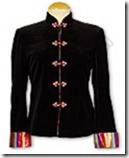This is a travel day: goodbye Shanghai, hello Beijing.
Early morning up and out – and a farewell to the Shanghai breakfast buffet that has been my morning pleasure. The kitchen opened early to feed us before we head off.
Service is big in China – after all, everything in China still runs to some degree on guanxi (relationships of reciprocity and exchange). Our fourth year in this hotel: we’re building guanxi.
The trip to the airport is on the maglev train, a quiet and comfortable magnetic levitation train that operates through Shanghai. It’ll cut the time of the trip by 75% as compared to the bus in on day one. The maglev is the first commercial high-speed line in the world, with test speeds clocked at more than 300 mph.
We fly to Beijing, drop our bags, change clothes, grab lunch, and head off to a company visit. Beijing traffic is amazing. Take a read of Peter Hessler’s Country Driving —my favorite of his books on China that I’ve talked about in a past blog – for an accurate and entertaining read why.
Beijing adds 2100 new cars a day to its roads, and a thousand plus people get a first driver’s license in the city every day. A car is a new symbol of affluence and rising social status in China. Envision a country where 1.3 million people are learning to drive for the first time – most not having seen their parents drive or even having ridden much in autos. Get the picture of gridlock? These should help fuel your imagination.
Things in China are ever changing, and staying flexible and open – a key leadership skill for everyone – is essential. We’re scheduled to visit ABB, but there may be a shift. Speakers and company visits have all been great – and I’m confident wherever we land will be amazing.
ABB is a Chinese-Swiss conglomerate and a leader in power and automation technologies that reduce environmental impact. We’ll explore the challenges of a multi-national setting up operations in China and sustainability issues, if all turns out as planned.
Tonight, those who choose are measured for their custom suits, shirts, or other choices. June’s the young entrepreneur tailor who made us all look fabulous last year.
She and her partner Ding and their cadre of seamstresses and seamsters plan to work their magic again this year, even though we have doubled our student numbers and are bringing some Midwest fashionistas with large, empty suitcases to fill. Learn more about D & J Tailors at http://www.tailorbeijing.com/about.php
I loved the silk Chinese jacket they custom-made for me last year. I am bringing pictures to inform some designs for this year’s purchases.
![clip_image004[6] clip_image004[6]](https://theleadershipprofessor.com/wp-content/uploads/2011/04/clip_image0046_thumb.jpg)
![clip_image002[6] clip_image002[6]](https://theleadershipprofessor.com/wp-content/uploads/2011/04/clip_image0026_thumb.jpg)
![clip_image002[4] clip_image002[4]](https://theleadershipprofessor.com/wp-content/uploads/2011/04/clip_image0024_thumb1.jpg)
![clip_image004[4] clip_image004[4]](https://theleadershipprofessor.com/wp-content/uploads/2011/04/clip_image0044_thumb1.jpg)


![clip_image009[4] clip_image009[4]](https://theleadershipprofessor.com/wp-content/uploads/2011/04/clip_image0094_thumb.jpg)
![clip_image011[4] clip_image011[4]](https://theleadershipprofessor.com/wp-content/uploads/2011/04/clip_image0114_thumb.jpg)

